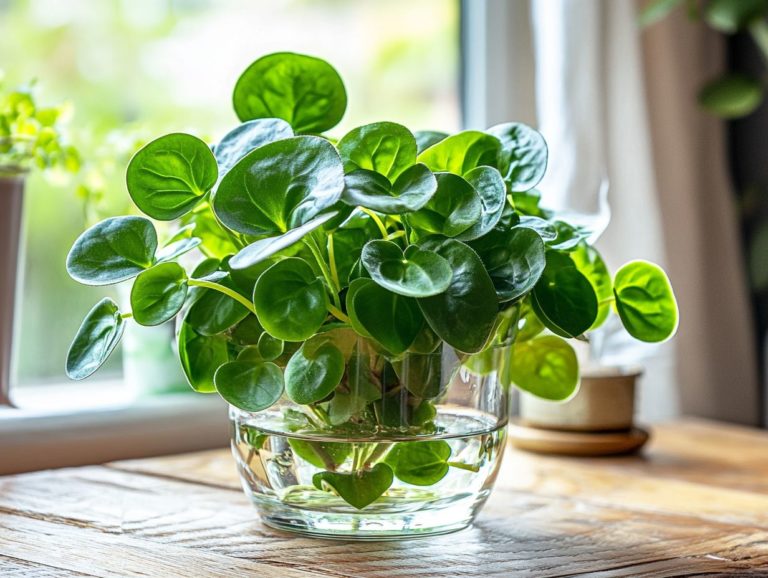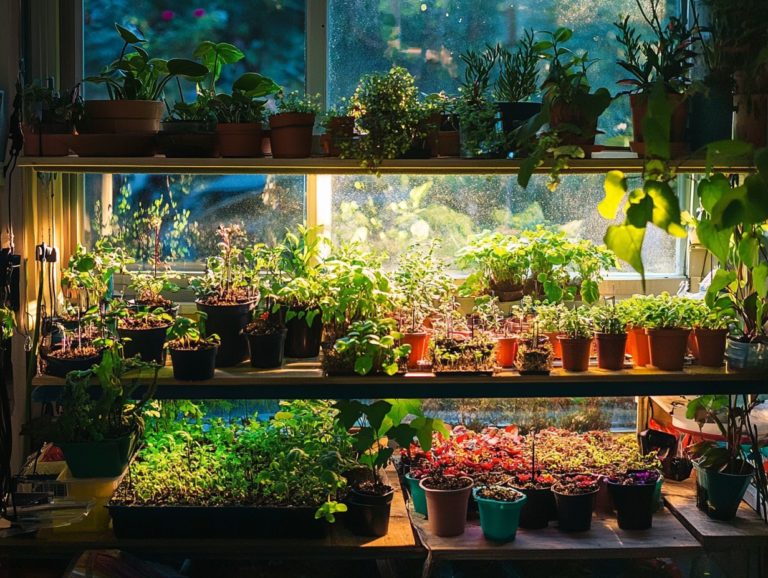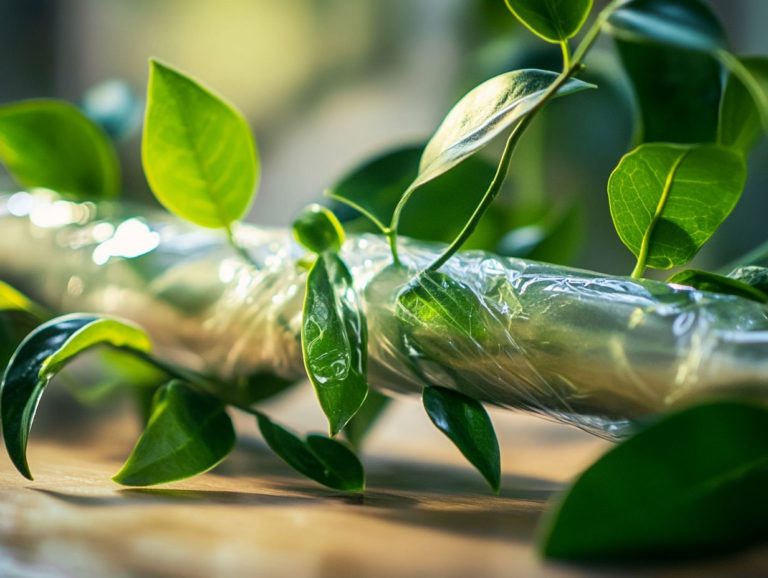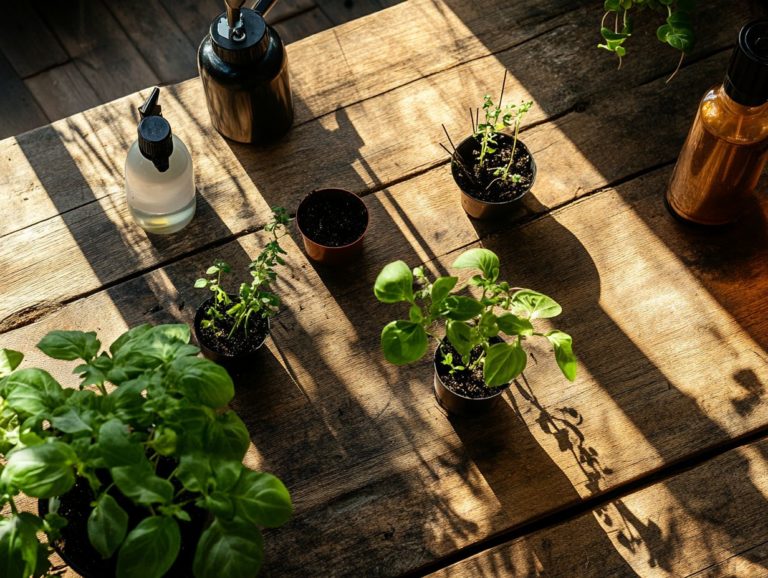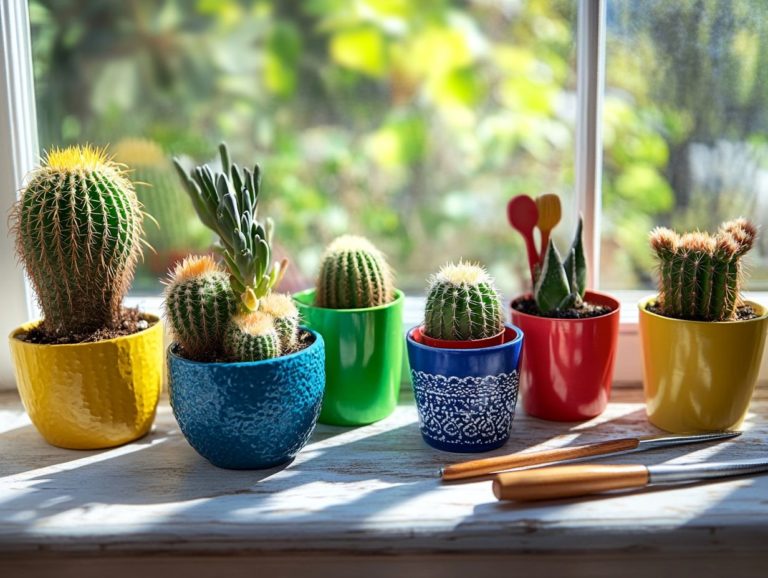5 Easy Methods for Propagating Houseplants
Are you eager to grow your indoor jungle without stretching your budget? Propagating houseplants offers a gratifying and economical approach to expanding your collection!
This article delves into five straightforward methods for propagation, such as water propagation, stem cuttings, and more. You ll uncover the perks of nurturing new plants, the essential tools you ll need, and valuable tips to set you on the path to success.
Whether you re a seasoned gardener or simply a curious beginner, this guide is designed to help you cultivate your green thumb with confidence, enhancing your plant care knowledge.
Contents
- Key Takeaways:
- 1. Water Propagation
- 2. Stem Cutting Propagation
- 3. Leaf Cutting Propagation
- 4. Division Propagation
- 5. Air Layering Propagation
- Why Propagate Your Houseplants?
- Frequently Asked Questions
- What are the 5 easy methods for propagating house plants?
- Which method is best for a variety of house plants?
- Can I use any type of stem for stem cutting?
- How long does it take for a stem cutting to develop roots?
- Is leaf cutting suitable for all house plants?
- Can I propagate a house plant without using these methods?
Key Takeaways:

- Water propagation is a simple and low-cost method for propagating houseplants, using only a jar of water and some patience while adhering to a consistent watering schedule.
- Stem cutting propagation is a popular and effective method for propagating a variety of houseplants, including succulents and herbs.
- Leaf cutting propagation is a great way to multiply your favorite foliage plants, such as pothos and snake plants, with just a single leaf.
1. Water Propagation
Water propagation is a favored and highly effective method for nurturing new houseplants from cuttings. It allows you to witness the root development of species like snake plants, pothos, and Christmas cacti in a clear propagation vase filled with water. This transforms the process into an engaging and educational experience!
To set yourself up for success, it s essential to choose healthy cuttings that include at least one leaf node, as this is where new roots will emerge. Using sterilized tools not only ensures a clean cut but also minimizes the risk of disease. This paves the way for robust root development.
Maintaining the right balance of bright light and moisture is crucial. Indirect sunlight is your best bet to prevent overheating, while consistent moisture ensures that your cuttings remain hydrated without drowning in water. By following these guidelines, you significantly enhance your chances of cultivating thriving new plants and achieving healthy growth. Get started with water propagation today and watch your garden flourish!
2. Stem Cutting Propagation
Stem cutting propagation is a fascinating journey where you take a cutting from the stem of a healthy mother plant and encourage it to develop strong roots. This method works wonders for various indoor plants like the golden pothos and heartleaf philodendron, which truly thrive under your attentive care!
To embark on this rewarding process, you ll want to grab a pair of sharp scissors or pruning shears. Clean cuts reduce stress on the plant and promote quicker healing, setting the stage for success. Once you’ve obtained your cutting, consider applying rooting hormone; this can significantly enhance root development and help your cutting transition smoothly into its new growing environment. Rooting hormone encourages root growth and helps the cutting establish itself.
Choosing the right potting mix is another essential step. A blend that offers excellent drainage while retaining moisture will provide the support your cutting needs for robust growth. Don’t forget, ensuring that your container has adequate drainage holes is crucial this prevents waterlogging and creates an ideal setting for your cutting to truly flourish. Follow these simple steps to see great results!
3. Leaf Cutting Propagation
Leaf cutting propagation is a remarkable method that allows you to grow new plants directly from leaves. This technique is particularly well-suited for houseplants like the prayer plant and spider plant, which can produce multiple plantlets from just a single leaf when given the right care and conditions!
For successful results, you must maintain a consistently humid environment around your cuttings. Utilizing a clear plastic bag or a humidity dome can be an excellent way to retain moisture, which is crucial for preventing the cuttings from drying out. Additionally, following these easy steps to propagate cacti indoors can enhance your propagation efforts. Adding perlite to your potting soil can significantly improve moisture retention, creating an ideal mix that fosters robust root development.
Finally, ensure your cuttings receive plenty of indirect light, as proper illumination is key to stimulating growth and strengthening those new plantlets as they emerge from the leaf cutting propagation method. Start your leaf cutting journey today and watch your collection grow!
4. Division Propagation
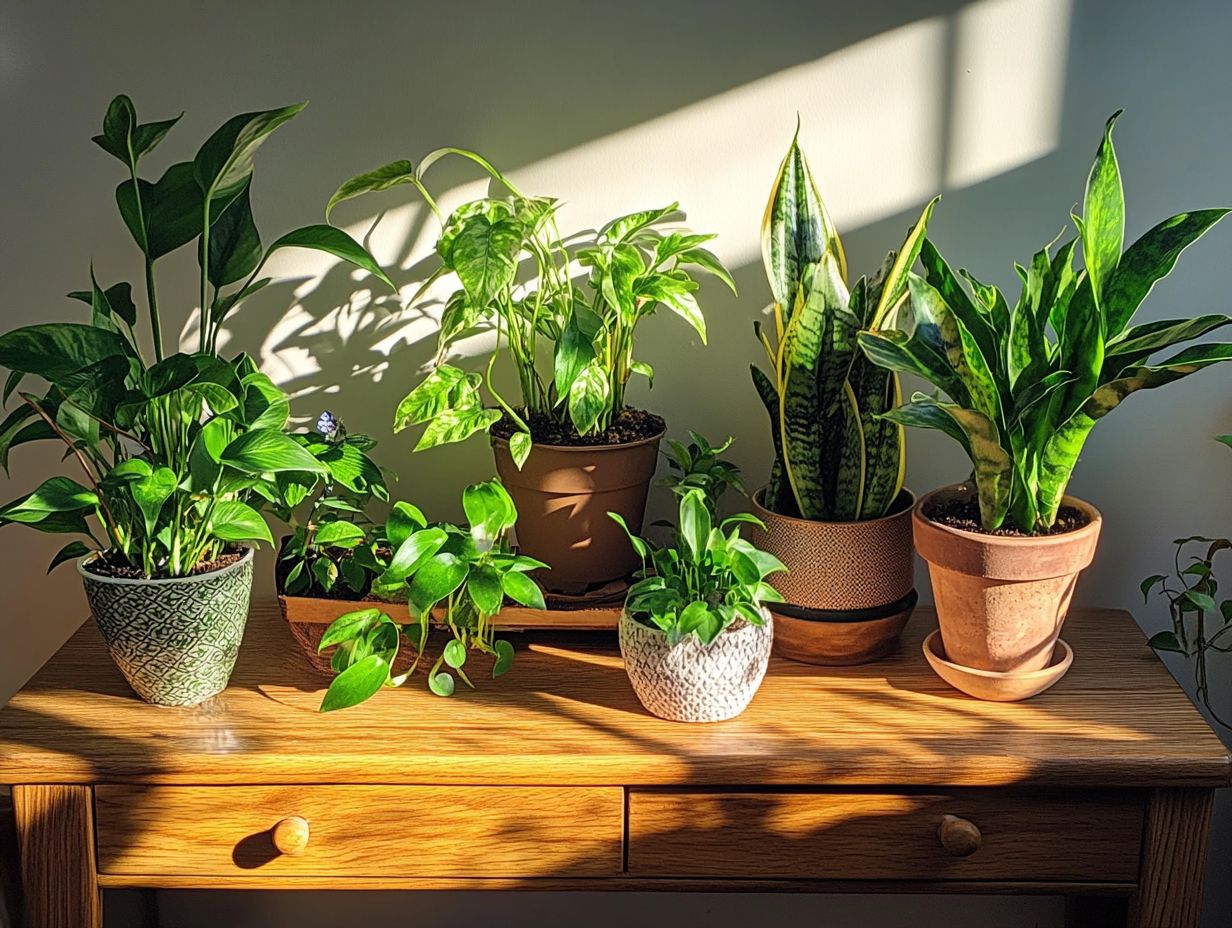
Division propagation is a simple yet effective way to expand your houseplant collection. By carefully separating offsets or pups from the main root system of a healthy mother plant, you can easily grow new specimens, especially with low-maintenance varieties like the Chinese money plant and snake plant.
Timing is everything in this endeavor. Aim for early spring or late summer when the plant is actively growing for the best results. Before you dive in, make sure you have clean, sterilized gardening tools on hand to prevent any unwanted diseases from hitching a ride.
After you’ve made the divisions, each new plant requires the right conditions to flourish. Ensure they receive adequate light, moisture, and nutrients. To boost their chances of successful establishment, consider keeping the freshly separated plants in a humid environment for the first few weeks. This extra care can make all the difference as they settle into their new homes.
5. Air Layering Propagation
Air layering is a refined technique that gives you the power to cultivate new plants while they remain attached to the mother plant. This method fosters the development of strong roots in a consistently moist environment, making it particularly advantageous for larger houseplants like the Swiss cheese vine.
- Select a healthy stem and make a small cut or scrape in the bark to reveal the layer just under the bark.
- Wrap the exposed area with generous amounts of moist sphagnum moss, which will retain moisture and encourage root growth.
- Secure the moss with plastic wrap or aluminum foil to maintain humidity, creating the perfect conditions for development.
- Keep the temperature warm, ideally around 70-80 F, and ensure the plant receives indirect light to further enhance the chances of success.
After several weeks, once robust roots have formed, you can carefully separate the new plant from the parent. This starts the new plant’s growth journey using effective propagation techniques for indoor plants.
Why Propagate Your Houseplants?
Propagating houseplants brings an array of advantages that you simply can t overlook. Not only can you expand your plant collection at little to no cost, but you also get to nurture new plants from robust mother plants. This process enhances your indoor gardening experience and promotes a sustainable approach to plant care.
Imagine the thrill of watching new plants grow! Think of it as an exciting opportunity to share the joy of gardening with friends and family, allowing them to revel in the beauty of new green companions without breaking the bank. By reusing plant material, you significantly reduce waste and embrace eco-friendly habits that benefit the planet.
Whether you’re diving into water propagation, soil propagation, or experimenting with cuttings, there’s immense satisfaction in watching roots develop and new leaves unfurl. However, to ensure your success, it’s important to be aware of common pitfalls. Check out the 5 mistakes to avoid when propagating plants. Each successful attempt cultivates a deeper appreciation for nature and fosters a sense of accomplishment in those eager to experiment and learn.
What Tools and Materials Do You Need for Propagation?
Having the right tools and materials is crucial for your plant propagation success. This ensures you can efficiently propagate a variety of houseplants, such as the string of hearts and Christmas cactus, while minimizing the risk of disease or damage to your precious cuttings.
To begin, sterilized scissors are a must to prevent any unwanted pathogens. Propagation vases are also invaluable, allowing you to easily monitor root development while facilitating water propagation. Don’t overlook rooting hormones; they can accelerate the process, promoting faster and stronger growth. For those interested in expanding their indoor garden, check out 8 common indoor plants and their propagation methods.
Finally, using a suitable potting mix guarantees that your new roots have access to essential nutrients and proper drainage, which are vital for healthy development. By grasping the significance of each of these gardening tools, you can create the ideal conditions for your favorite plants to flourish during propagation.
What Are the Best Plants for Each Way to Grow New Plants?
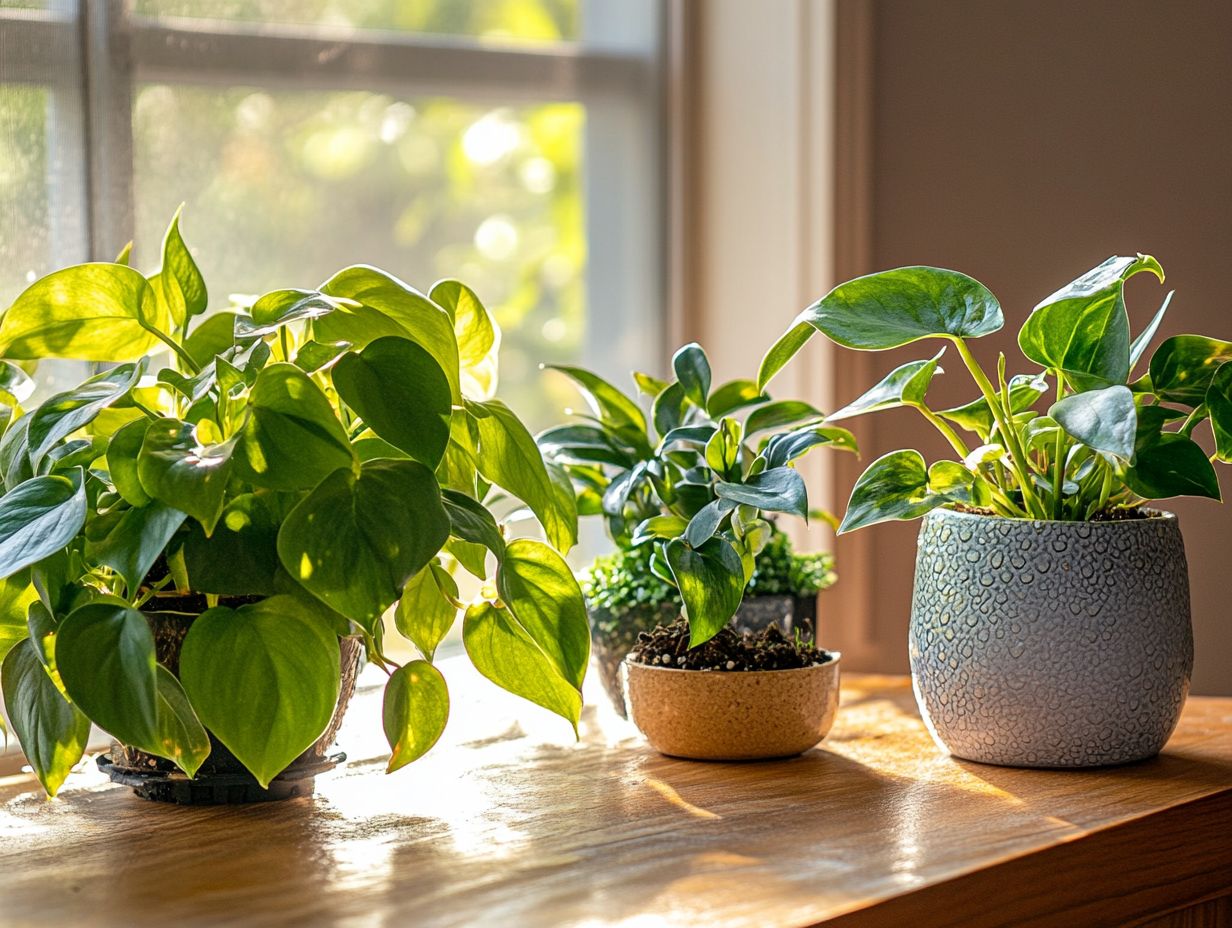
Different ways to grow new plants are tailored for specific plants. For example, snake plants and pothos thrive with stem cutting propagation. In contrast, leaf cutting propagation excels with varieties like the prayer plant and spider plant. Choosing the right method can lead to amazing growth!
Understanding the subtleties of each propagation method can significantly elevate your gardening success. Certain plants flourish when their stem sections are placed in water or soil, as seen with the remarkable growth rates of snake plants and pothos. For those looking to enhance their indoor gardening, exploring 5 ways to promote healthy indoor plants can be especially rewarding. Leaf cutting propagation can be particularly effective for plants like the spider plant, which can produce new growth from just a single leaf.
By identifying which species respond best to specific techniques, you can cultivate lush, healthy greenery and expand your plant collection while saving both time and effort in your gardening endeavors.
How Long Does It Take for the Plants to Root and Grow?
The time it takes for your houseplants to root and grow can vary significantly based on the propagation method you choose. Water propagation may take several weeks to establish roots, while division propagation can yield almost instant results when you separate offsets patience and care are essential.
Soil propagation is another critical method that influences your timeline, ranging from a few weeks to several months, depending on the species and environmental conditions. Factors like temperature, humidity, and light exposure play a vital role in how quickly your plants will flourish. For those interested in learning more specific techniques, check out A Beginner’s Guide to Plant Propagation. Tropical plants thrive in warmer, more humid settings, which can help them root faster in ideal conditions.
To maximize your success, regularly monitor and care for your plants. Proper watering and nutrient management can significantly enhance propagation outcomes, leading to healthier, more robust plants down the line.
What Are the Common Mistakes to Avoid in Plant Propagation?
Many gardeners face common pitfalls during plant propagation that can obstruct healthy growth. Overwatering cuttings, neglecting to use clean and sterilized tools, or not providing adequate light and humidity can all contribute to unsuccessful propagation efforts.
Being aware of these challenges can ensure your success in propagating plants. For instance, overwatering can lead to root rot. Developing the habit of checking soil moisture before watering can change the game. Using clean, sterilized tools not only helps prevent the spread of diseases but also encourages healthier plant development. Additionally, knowing the best indoor plants for propagation can enhance your gardening success.
Providing the appropriate light conditions, whether it’s indirect sunlight or grow lights, can significantly enhance your chances of successful rooting. Monitoring humidity levels is crucial since many cuttings thrive in higher humidity until they establish roots. For those interested in expanding their knowledge, learning how to propagate herbs indoors can greatly enhance your propagation success rate.
What Are Some Tips for Successful Plant Propagation?
Successful plant propagation requires your keen attention to detail. Key tips to keep in mind include maintaining a consistent watering schedule, ensuring adequate moisture and humidity, and using rooting hormone to boost root development for flourishing houseplants like the Chinese money plant and snake plant.
Create the ideal environment for growth by placing your cuttings in a well-lit area, but avoid direct sunlight as those intense rays can really hinder their progress. To learn more about this process, check out our guide on how to propagate your favorite houseplants. Monitor the temperature, targeting a range that encourages root establishment while steering clear of drafts. Regularly checking for signs of pests or disease can significantly enhance your chances of success.
Using clean, sterilized tools during the propagation process helps minimize contamination risks. Keeping the soil well-aerated ensures that roots can develop easily. By following these practices, you can cultivate healthy new plants that will thrive beautifully in your home environment. For more detailed techniques, check out how to propagate succulents successfully.
Frequently Asked Questions
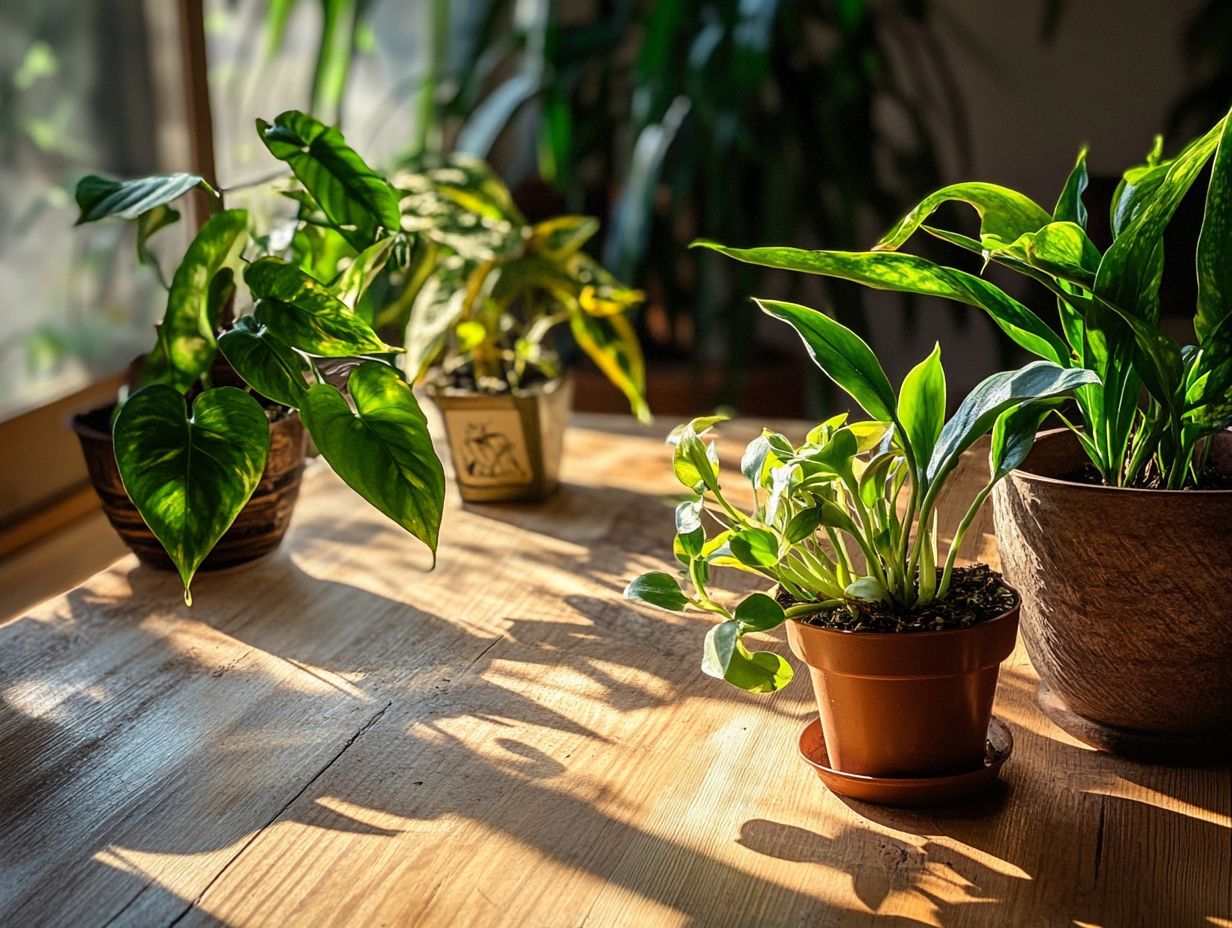
What are the 5 easy methods for propagating house plants?
Here are five easy methods: stem cutting, leaf cutting, division, layering, and seed propagation.
Which method is best for a variety of house plants?
Stem cutting is the best choice. It s simple and effective for growing new plants from existing ones.
Can I use any type of stem for stem cutting?
Absolutely! You can use any healthy stem, as long as it has at least 2-3 nodes. Nodes are the spots on the stem where leaves sprout.
How long does it take for a stem cutting to develop roots?
It typically takes 2-4 weeks for a stem cutting to develop roots. Some plants may take longer, so be patient and keep an eye on it.
Is leaf cutting suitable for all house plants?
No, leaf cutting isn t for every plant. It works best for those with thick leaves, like succulents and begonias.
Can I propagate a house plant without using these methods?
Yes! You can propagate through division. This involves separating the plant into smaller sections and planting them individually.

